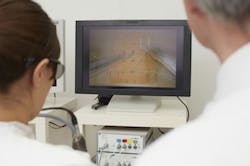Study shows 3D display technology benefits surgeons
Berlin, Germany--Until now, physicians have largely been skeptical of the advantages of 3D display technology—but this may be about to change: the findings of a new study show that even experienced surgeons stand to benefit from the third dimension. The study was done at the Fraunhofer Institute for Telecommunications, Heinrich Hertz Institute (HHI) and Klinikum rechts der Isar University Hospital (Munich, Germany).
The tests showed that 3D systems used in medical technology, including improved 3D glasses and screens, have benefits that were once believed to be purely theoretical; even experienced physicians could benefit from the latest generation of 3D devices. Traditionally, doctors have been rather skeptical of 3D images, but in tests conducted over the course of the study some 50 surgeons responded positively to 3D systems both with and without glasses.
“While the technology still requires some fine-tuning, technology that does without the need to wear special glasses will increase the popularity of 3D systems in operating rooms," says Ulrich Leiner, head of the Interactive Media – Human Factors department at HHI. "In the past, surgeons were hesitant to use the technology precisely because of the glasses."
The study was conducted as a result of current developments in 3D screen technology. 4K models for medical applications that offer quad HD resolution are already available. “The next step is ultrahigh definition with 8K,” says Michael Witte of HHI. "This will mark a sixteenfold improvement on the resolution of currently available full-HD images."
Four types of tests
Surgeons participating in the test tried a total of four different screen systems: 2D, 3D with and without glasses, and a mirror apparatus that served as the “ideal” 3D model. Images were delivered by endoscopic cameras that the doctors used during a simulated routine surgical procedure. Using a needle and thread, the physicians sewed up a wound with ten stitches in a model abdominal cavity. Just as would be the case in a minimally invasive surgical procedure, the surgeons did not have a direct view of their hands, and thus depended on the screen.
“The results were astonishing: with the glasses-based 3D system, the procedure was more than 15% shorter, and precision increased considerably,” says Hubertus Feussner, a surgeon at Klinikum rechts der Isar. "Hand movements were more targeted than with the 2D model. As far as I know, we have not observed this effect among our experienced surgeons in the past." Feussner has conducted several thousand operations.
“In the past, it was the most experienced physicians in particular who were very skeptical of 3D technology," notes Silvano Reiser, Feussner’s colleague. "And this was not only because it hardly offered any tangible benefits. Many physicians felt uncomfortable looking at the screens, and preferred to rely on their experience as a result."
Model without glasses is the future of 3D
The model without glasses also made a positive impression: test participants considered its quality as comparable to 2D. “Unfortunately, the system we developed was unable to take the first place ranking," says Leiner. "But the first ‘hard’ practical medical test showed great promise, as we were able to work on the fundamental eye-tracking technology. This is where, through eye tracking, cameras follow both eyes, and each eye sees a separate image. This creates a 3D effect without glasses."
About the Author
John Wallace
Senior Technical Editor (1998-2022)
John Wallace was with Laser Focus World for nearly 25 years, retiring in late June 2022. He obtained a bachelor's degree in mechanical engineering and physics at Rutgers University and a master's in optical engineering at the University of Rochester. Before becoming an editor, John worked as an engineer at RCA, Exxon, Eastman Kodak, and GCA Corporation.

